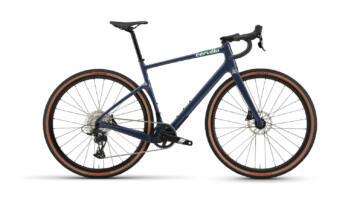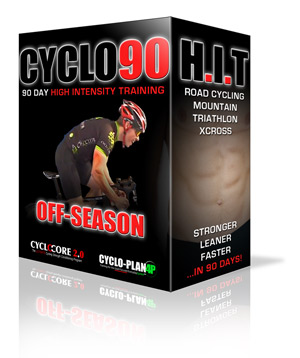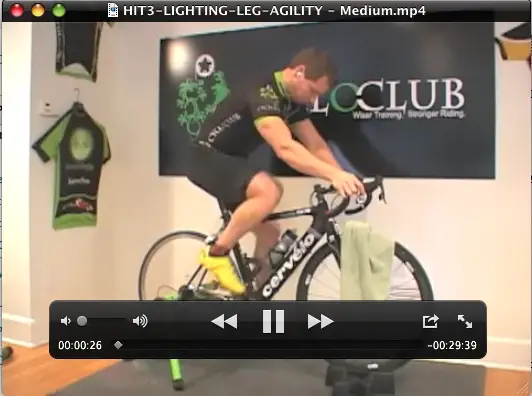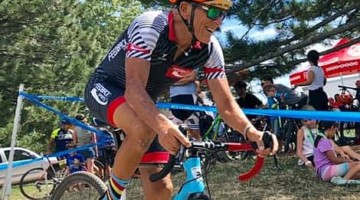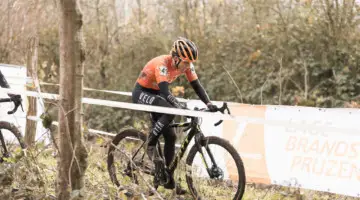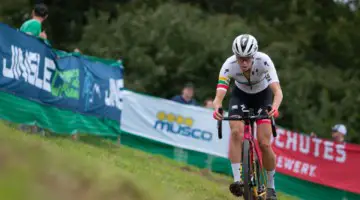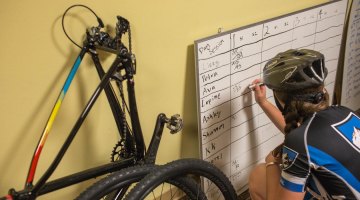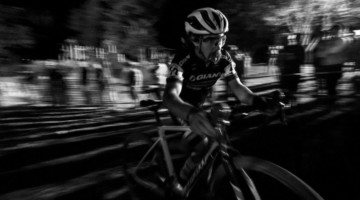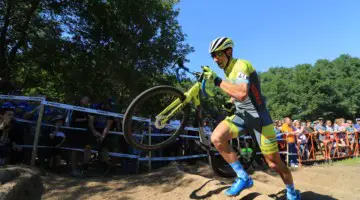Looking to get ready for cyclocross on the off-season but finding yourself short on time? We looked into the Cyclo90 H.I.T. Program last winter, but now might be the perfect time to get into it again, if you’re looking for something quick to ramp up for September.
Training plans have always interested us here at Cyclocross Magazine. After all, we’re all racers ourselves looking to get faster! We’ve heard every side of the story, from a focus on long, endurance-based rides to build aerobic stamina to five-hour training weeks in order to stay fresh for races, and we’ve talked to pros whose training plans have differed so wildly that, upon seeing the racers at the front of the pack, we had to ask, “How were they both right?”
Of course, as we all know, there is no one magical formula. But we were intrigued when we heard about Cyclo90 H.I.T from coach Graeme Street. For the Masters racer with a full-time job, family obligations and a life outside of cycling, Street’s plan seems pretty stellar: focus on quality work at high intensity, and fitness will follow. But while “The Everyday Cyclist” may represent the majority of Street’s client base, many of the workouts are extremely challenging, and there’s plenty in there to put the hurt on top Elite racers too.
Today, we’re sitting down with Street to hear a bit more about his plan and to find out how it can work within a cyclocrosser’s life. To follow up, we’ll be subjecting ourselves to these workouts to test them out and will be posting our review here at cxmagazine.com. The program is available either as a DVD or a download, and there’s a package that includes a written training program to follow for 90 days, at which point Street guarantees that the rider will be “stronger, leaner and more powerful on the bike.” Although not geared specifically for cyclocross, the H.I.T. (or high-intensity training) efforts target building the top end – crucial to ’cross. Set up in workouts for on the bike (where Graeme “does” the workout with you on the video) and off the bike (the core work is intense!), the workout program as a whole is great for the off-season, and the individual workouts can still be scattered throughout the cyclocross season, especially when bad weather forces you indoors. You can learn more about the Cyclo90 program on the Cyclo-CORE website, and be sure to check out our review of the product here.
Cyclocross Magazine: Looking at this plan, it seems like a reasonable one for a roadie, but will this help cyclocrossers specifically? How will it be beneficial, especially in the winter?
Graeme Street: What I’d recommend for a cyclocross racer would be to use the plan as an off-season training format. It’s different from traditional methods like aerobic base building. I’m not an advocate of that type of training. With this program, we prioritize strength building in a functional way: leg presses aren’t functional, but the cyclocrosser wants to get stronger in the off-season and hold fitness into September, October and beyond, so we use functional strength training.
What I recommend is using it beginning December 1 or January 15, whenever your season finishes. A longer delay might not be a bad idea because you need recovery post-season so you can move into your next season and not blow yourself apart. I would not recommend you use the system, for example, in the middle of June: you’ll get really strong and get really fit, but I’d question if you could hold that fitness through the cyclocross season. I would start in December-January, then drop the plan, then reacquire it again in August.
The way I organize those workouts, I try to build it so that it’s outside two-thirds of the time, practicing things we do inside on the trainer during the videos. I want to use the trainer as a tool to teach, practice and refine, and we do that in short, sweet bursts. Then a couple days later, I’ll have you outside practicing.
CXM: But what about fitting in cyclocross-specific training?
GS: The plan is pretty straightforward: if you want to do skills instead, you can switch to them. I build my plans with the understanding that my clients won’t always follow them exactly. It’s the 80:20 rule. 80 percent of the time, follow what I want you to do, and 20 percent of the time, you do what you want to do, in this case, skill-work, and you’ll still get the results.
The only problem is when cyclists are doing high intensity and try to add volume on top. If you go into it with an open mind and let fitness percolate, you’ll find that you’ll make more progress. It’s more refined: When we’re working, we’re working hard, and when we’re resting, we’re resting hard.
CXM: What about with racing? How does the plan work?
GS: It’s not technically designed for someone racing both Saturday and Sunday of every week, but a practical person can look at the program and know how to modify it, to tone down the Thursday and Friday sessions. It’s natural for all racers to want to add more, but you have to have a perfect balance between intensity and recovery or you’re going to just be missing that mark every time. In cyclocross, everyone’s hurting, within reason, the same. There’s not one person on the field who isn’t in tremendous discomfort!
CXM: So what makes your program different from others out there?
GS: I created this because my trainer session videos were so popular. They were popular because they were consolidated and shorter and clients knew that they could get something out of that 30 minutes. When I started to realize the idea was beginning to click, that focused quality was better than unfocused quantity, I decided to put them into the more refined program. Then I added in the Core 2.0 sessions to balance it out.
Most training plans don’t have the video, but the digital age is definitely here with the download option. I can get it to you cheaper, faster and with more stuff included digitally.
CXM: What kind of workouts can a person on this plan expect?
GS: The high intensity sessions can be between 30 and 90 minutes, but I would never have one for more than 90 minutes. Once you hit that marker, you have to be able to walk away, not add another hour, or you’re reversing the positive effects of the workout. Experts don’t talk about it, coaches don’t talk about it, but my understandings of the inside workings of the sport and the parameters inside each of our bodies show that once we hit that marker, we need to know it’s time to get out. And this is how athletes tend to make their mistakes. We have to listen to our bodies. You have to be willing to sacrifice and say, “I’m done today.”
CXM: What kind of cyclist or racer is this targeted towards?
GS: My bread and butter is 35- to 65-year-old cyclists, and I call them the everyday cyclists. We balance our daily life: work, kids, et cetera, along with our passion to improve on the bicycle. Improve is key there: there’s a community of us that seek out more from our bike than just pleasure. We have a drive keeping us interested. I don’t care if the person is a racer, I care that they want to ride and overcome obstacles and get more joy from what they’re doing.
My biggest target with the everyday cyclist is asking them to decide if they just want to ride or if they want to ride and improve, and I want to work with the ones who want to improve. You can just ride and improve, but at some point, you’ll hit a plateau.
CXM: Why the core work and off-the-bike sessions?
GS: If it’s faster leg speed we’re trying to improve, or balancing left and right leg, it’s going to affect how much power you’re going to produce, so we need to get you off the bike. I’ve got a strength workout, a power workout and an agility workout. We’re getting you off the bike, attacking the body from multiple angles, and then getting you back on the bike.
One thing that frustrates me is when programs just say, “go to the gym and train for 60 minutes.” Most cyclists think that means go in and do squats and leg presses, but those are linear based, not functionally-based.
CXM: What’s your best advice for someone starting a program?
GS: I built Cyclo90 system in particular to be modulated by taking little blocks and then piecing them together. Between the written workouts, the DVD or download, and the Core 2.0, the permutations are in the hundreds of thousands. I created the program for moderate riders and beginners, and then added the advanced option.
CXM: We have to ask: Why short and sharp efforts?
GS: I’ve never been an advocate of volume training. To make progress in anything, you have to make yourself uncomfortable. We’ve been told to ride at 70 percent for hours to burn fat. At what point does someone realize, “I’m beyond that now?”
It’s not an all or nothing principle: again, every workout isn’t high intensity. I do believe in endurance rides. I don’t believe in endless zone two or three miles like you see in some coach’s plans. I’m a believer in functional strength and higher-level fitness and then adding in endurance last.
There are a lot of riders with two kids, who work 70 hours a week. I built Cyclo90 to be short, sweet and to the point: there’s nothing extra.
I don’t believe every workout has to be high intensity. Just between 30 minutes and two hours total in a seven-day cycle. I’m looking to move the intensity meter beyond what your body can handle.
CXM: What kind of results can racers expect to see within the 90 days?
GS: You’ll see a major improvement with your core strength, that’s the biggest thing you’ll realize. Ripped abs, though that’s not what we’re after, you’ll probably get that. But we’ll burn body fat and improve functional strength for the bike. Doing this in December to January, most people can expect to not put on typical off-season weight gain; they’ll typically take off weight in the off-season.
I’m going to attack you in ways the bicycle cannot. And when you get back on the bike, you’ll see dramatic improvement in your form and function on the bike. The only way a person can lose with this program is if the person doesn’t do the work or does way more work than I ask. If you can do more and can add more to it, then you didn’t do those workouts correctly.
Stay tuned for our review of the program!
The Cyclo90 H.I.T Program consists of three parts:
- Cyclo-CORE 2.0 (5 off-bike workouts)
- Cyclo-H.I.T. 30 (6 on-bike, 30-minute workouts)
- CYCLO90 High Intensity Training Plan
Download is $99.95
DVDs are $119.95 plus shipping.
More info about the program on the Cyclo-CORE website, and check out our review here!











